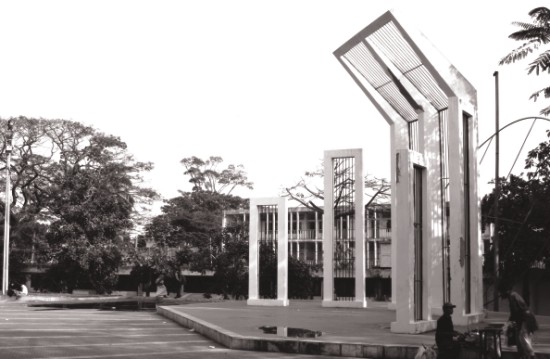|
Photo Feature
The Legacy of Language
Photographs: Zahedul I. Khan
Text: Nader Rahman

February is a month like none other, it sneaks up on one and before you know it, it's over. In Bangladesh the cupids of Valentine are still stringing their bows when Ekushey comes along exactly a week later. Once a year the nation beats from its surrogated heart, the Shaheed Minar. Many people consider the language movement of '52 as the major impetus behind the larger picture of Bangali nationalism, that point may be debated but its importance cannot. 56 years ago there was an uprising like none before, people fought not for land or territory but for their language and culture, which stood as intangible as the courage they showed. Abdus Salam, Rafiq Uddin Ahmed, Abul Barkat, Abdul Jabbar and Shafiur Rahman were martyred in the ensuing struggle, their blood may have dried and washed away decades ago, but they left a stain on the nation and the place of their death that will never fade. The very place of their death is revered and in the years to follow became the central point for future revolutions, the magnetic air of the Shaheed Minar has attracted its fair share of artists, lovers and revolutionaries and everyone in between as it stands, as a testament to the spirit of resistance. What is not commonly knows is that the very first Shaheed Minar was made in 1952 on the night of the 23rd of February when students from the adjourning Dhaka Medical College worked all night to build a monument for those who had lost their lives. On the morning of the 24th they put up their Minar with a little note reading 'Shaheed Smritistombho' attached to it. Within two days the structure was destroyed by the Pakistani army amid great protest. One year later people gathered at the same spot to remember those who lay down their lives and from that point onwards it has remained at the epicentre of Bangali nationalism. Within a few years Bangla was finally declared a state language there were plans to create a new monument. Renowned architect Hamidur Rahman designed what was to be the new Shaheed Minar and the elaborate project eventually proved to be too much to complete. On the 21st of February the new monument was inaugurated by Abul Barkat's mother, but it would not last long. By the end of The Liberation War in late 1971 it was almost entirely demolished by the Pakistan forces and needed to be rebuilt. Hamidur Rahman took the project on again and produced what we see now. A trip to Shaheed Minar now is a walk into a leafy paradise far from its tumultuous origin more than fifty years ago. Lovers hold hands, children play cricket and people just stop by to relax. It has become a community centre of sorts which binds us with the language we speak. When people die their bodies are brought to Shaheed Minar as it seems even in death they soak up its unrivalled atmosphere. As the day draws nearer it is a hub of excitement, as students paint the adjacent walls and the ground is covered in flowers, the Shaheed Minar is the centre of what it is to be a Bangladeshi. February is Ekushey.


Copyright
(R) thedailystar.net 2008 |
|
